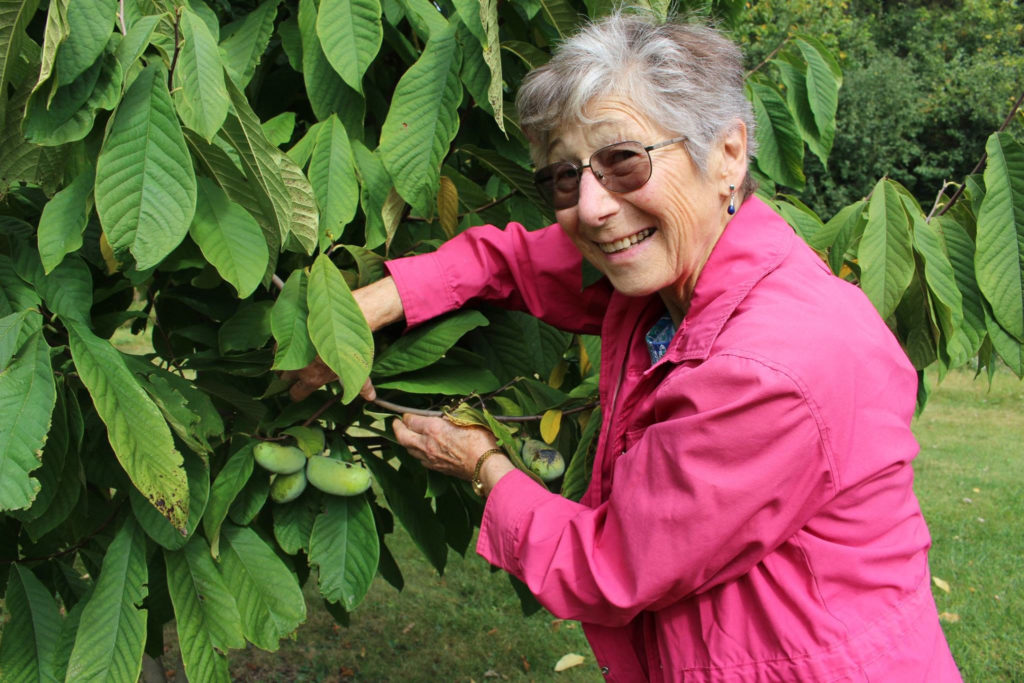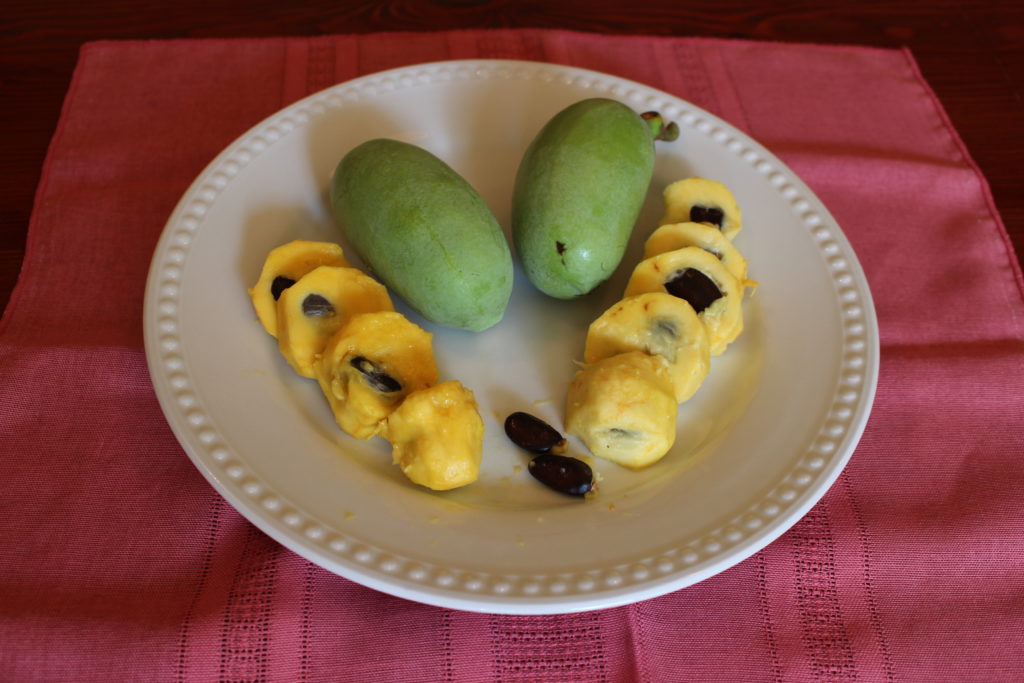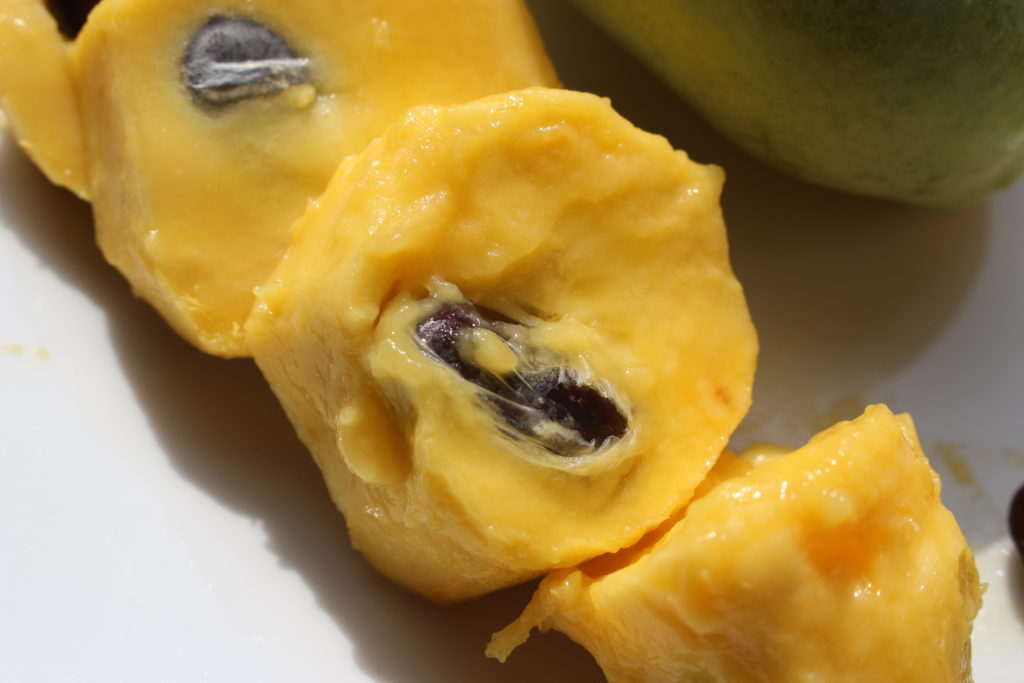Have you ever eaten a pawpaw?
I just tasted one for the first time. It brought to mind the phrase from Psalm 34:8 – “O taste and see that the LORD is good…”
Linda Wiens, pictured here, is in the middle of this story. A former staff member and current volunteer for the non-profit organization for which I work, Linda organized the planting of a small demonstration orchard near our office a number of years ago. Among the American quinces, apples, pears, persimmons, cherries, plums, and other fruit trees she had planted, there were two pawpaw trees.

Linda Wiens, a long-time member of a local Mennonite congregation, shows the fruit of a pawpaw tree that she had planted with many other kinds of fruit trees in a small orchard.
This fall, one of the pawpaws bore fruit for the first time.
As way of background, here’s the first paragraph of the first chapter of Andrew Moore’s excellent book – Pawpaw: In Search of America’s Forgotten Fruit:
Throughout the years it’s gone by a lot of names – frost banana, Indiana banana, fetid-bush, bandango, custard apple, prairie banana, poor man’s banana – but most of the time it’s just been called pawpaw. At first glance, both the fruit and the tree seem out of place in North America. A cluster of young pawpaws hanging from its branch resembles a miniature hand of bananas. And those clusters are tucked behind the tree’s lush foliage, shaded by leaves often a foot in length, larger and broader than those of avocado and mango. Wild pawpaws often appear kidney-shaped, two to six inches long, and one to three inches wide; they typically weigh from just a few ounces to half a pound. But under cultivation – and yes, there are pawpaw breeders and growers – fruits that weigh more than a pound and half are not uncommon.
This native American fruit can be found in 26 states. The heart of its range runs from the far eastern side of Kansas all the way to the Atlantic Ocean. The line formed by the northern borders of North Carolina, Tennessee, and Arkansas roughly forms the range’s east-west backbone. Check out the map (you’ll need to scroll down a bit) in this good online growing guide.
Speaking of geography, if someone tells you they’re from a town called Paw Paw, you’ll need to ask them which one. Six states – Illinois, Indiana, Kansas, Kentucky, Michigan, and West Virginia – have a town called Paw Paw. And there would be seven if you counted Paw Paw Island in Louisiana.
George Washington planted pawpaws at Mount Vernon. Thomas Jefferson sent pawpaw seeds to Europe. It was even a big part of the Lewis and Clark Expedition’s diet in the last week of their trip back to Saint Louis.
It’s a part of American history that we had forgotten. And it’s now being rediscovered.
But wait, you say, what does it taste like? How do you eat it?

You can slice pawpaws up in cross-sections (after peeling off the skin) or cut them in half length-wise and spoon out the flesh of the fruit.

You will likely never find a fresh pawpaw in your local grocery store. It has a very short shelf life, and it will not ripen if picked prematurely. To paraphrase the third chapter of Ecclesiastes, there is a time to eat pawpaws and there is a time to wait for the next pawpaw season.
I found the taste something like a mix of banana, mango, and custard. The consistency reminded me of a well-ripened avocado.
And I liked it! Despite having to work around the large black seeds, I liked the flavor.
(In the spirit of full disclosure, I cut up more cross-sections for our Friday staff meeting in early October. Some of my colleagues appreciated the novel taste. Others did not.)
There are many culinary options for this American fruit. We know that the Iroquois, for example, dried pawpaws and then used them in sauces and also cooked them into corn cakes. This worked well nutritionally. Corn is very low in niacin while pawpaw is rich in it. Native Americans found the tree and its fruit so useful that they spread the tree west of the Mississippi and north into the area around Ontario.
At the annual Ohio Pawpaw Festival in Athens County, Ohio, you can taste a wide variety of foods in which people are using pawpaws.
Salsas. Curries. Puddings. Mousse. Crepes. Ice Cream. All with pawpaws.
And that’s not even mentioning the many micro-brews. Like the Pawpaw Sour Ale from Upland Brewing Company and Putnam’s Pawpaw Ale from Marietta Brewing. There is also the Paw Paw Wheat from Jackie O’s Brewery in Athens, Ohio.
I could go on for a long time about this fascinating plant and its lore. I’d like to tell you more about the fact that zebra swallowtail butterflies can only persist as long as there are pawpaws. Or that pawpaw trees contain complex chemical compounds that fight cancer.
But I want to end with a question.
How does the pawpaw fit into your understanding of God’s world?
Are theology, prayer, and worship in a church building the only ways to know and connect with God? Or is God also with us and pleased with us when we immerse ourselves in this complex world and understand, appreciate, savor, and mend it?
I’d vote for the latter. And I’d say pawpaws are a good place to start.
I urge Christians and churches to plant native species of trees, shrubs, grasses, and flowers in their landscapes. If you’re in the home range of pawpaws and have the right conditions, why not plant a few of them? I planted two last year on the east side of our house where it’s not too windy and the soil rarely dries out completely. (By the way, you need to plant two or more pawpaws relatively close to each other for the trees to have a chance to bear fruit). According to this article from Indianapolis, at least one church and a synagogue have planted pawpaws. If you’ve heard of others, please let me know!





While I was in prayer the previous Sunday
I saw a papaw
What mostly I have good attention was the dark black seeds
So I thought to check how it relates to what I pictured or suddenly imagined
However it’s nice to see scripture even inside a papaw search.
Thanks for sharing your experience!